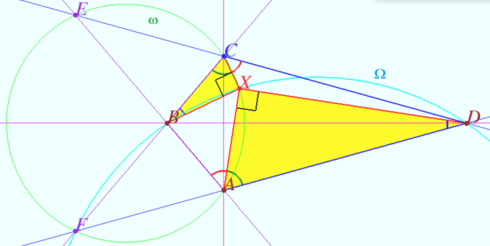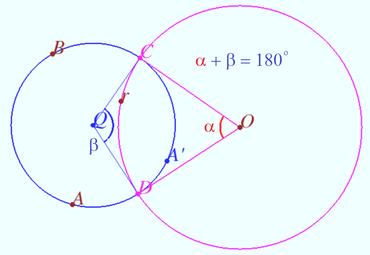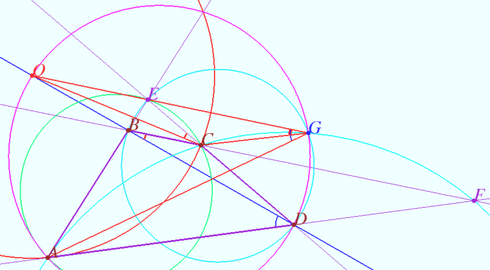Difference between revisions of "2018 IMO Problems/Problem 6"
(→Solution) |
(→Solution) |
||
| Line 55: | Line 55: | ||
Circles <math>ACF</math> and <math>ACE</math> are symmetric with respect to the circle <math>\omega</math> <i><b>(Lemma).</b></i> | Circles <math>ACF</math> and <math>ACE</math> are symmetric with respect to the circle <math>\omega</math> <i><b>(Lemma).</b></i> | ||
| − | Denote by <math> | + | Denote by <math>X_0</math> the point of intersection of the circles <math>BDF</math> and <math>ACE.</math> |
Quadrangle <math>BX_0DF</math> is cyclic, hence, <math>\angle X_0BC = \angle X_0DA.</math> | Quadrangle <math>BX_0DF</math> is cyclic, hence, <math>\angle X_0BC = \angle X_0DA.</math> | ||
Quadrangle <math>AX_0CE</math> is cyclic, hence, <math>\angle X_0AB = \angle X_0CD = \alpha.</math> | Quadrangle <math>AX_0CE</math> is cyclic, hence, <math>\angle X_0AB = \angle X_0CD = \alpha.</math> | ||
The required point <math>X = X_0</math> is constructed. | The required point <math>X = X_0</math> is constructed. | ||
Revision as of 06:46, 19 August 2022
A convex quadrilateral ![]() satisfies
satisfies ![]() Point
Point ![]() lies inside
lies inside
![]() so that
so that
![]() and
and ![]() Prove that
Prove that ![]()
Solution
Special case
We construct point ![]() and prove that
and prove that ![]() coincides with the point
coincides with the point ![]()
Let ![]() and
and ![]()
Let ![]() and
and ![]() be the intersection points of
be the intersection points of ![]() and
and ![]() and
and ![]() and
and ![]() respectively.
respectively.
The points ![]() and
and ![]() are symmetric with respect to the circle
are symmetric with respect to the circle ![]() (Claim 1).
(Claim 1).
The circle ![]() is orthogonal to the circle
is orthogonal to the circle ![]() (Claim 2).
(Claim 2).
Let ![]() be the point of intersection of the circles
be the point of intersection of the circles ![]() and
and ![]() Quadrilateral
Quadrilateral ![]() is cyclic
is cyclic ![]()
![]()
Analogically, quadrangle ![]() is cyclic
is cyclic ![]() .
.
This means that point ![]() coincides with the point
coincides with the point ![]() .
.
![]() of
of ![]()
![]() of
of ![]()
The sum ![]() (Claim 3)
(Claim 3) ![]()
![]()
Similarly, ![]()
Claim 1 Let ![]() and
and ![]() be arbitrary points on a circle
be arbitrary points on a circle ![]() be the middle perpendicular to the segment
be the middle perpendicular to the segment ![]() Then the straight lines
Then the straight lines ![]() and
and ![]() intersect
intersect ![]() at the points
at the points ![]() and
and ![]() symmetric with respect to
symmetric with respect to ![]()
Claim 2 Let points ![]() and
and ![]() be symmetric with respect to the circle
be symmetric with respect to the circle ![]() Then any circle
Then any circle ![]() passing through these points is orthogonal to
passing through these points is orthogonal to ![]()
Claim 3 The sum of the arcs between the points of intersection of two perpendicular circles is ![]() In the figure they are a blue and red arcs
In the figure they are a blue and red arcs ![]()
Common case
Denote by ![]() the intersection point of the perpendicular bisector of
the intersection point of the perpendicular bisector of ![]() and
and ![]() Let
Let ![]() be a circle (red) with center
be a circle (red) with center ![]() and radius
and radius ![]()
The points ![]() and
and ![]() are symmetric with respect to the circle
are symmetric with respect to the circle ![]() (Claim 1).
(Claim 1).
The circles ![]() and
and ![]() are orthogonal to the circle
are orthogonal to the circle ![]() (Claim 2).
(Claim 2).
Circles ![]() and
and ![]() are symmetric with respect to the circle
are symmetric with respect to the circle ![]() (Lemma).
(Lemma).
Denote by ![]() the point of intersection of the circles
the point of intersection of the circles ![]() and
and ![]() Quadrangle
Quadrangle ![]() is cyclic, hence,
is cyclic, hence, ![]() Quadrangle
Quadrangle ![]() is cyclic, hence,
is cyclic, hence, ![]() The required point
The required point ![]() is constructed.
is constructed.












